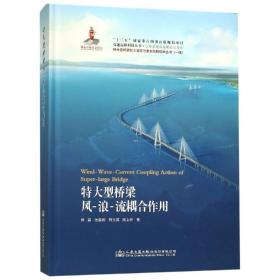
特大型桥梁风-浪-流耦合作用
正版保障 假一赔十 可开发票
¥ 143.66 7.8折 ¥ 185 全新
库存6件
广东广州
认证卖家担保交易快速发货售后保障
作者刘高
出版社人民交通出版社
ISBN9787114147371
出版时间2019-04
装帧平装
开本16开
定价185元
货号27851550
上书时间2024-10-27
- 最新上架
商品详情
- 品相描述:全新
- 商品描述
-
导语摘要
本书针对跨海特大型桥梁面临的深水、强风、巨浪、急流等复杂恶劣环境挑战,面向跨海桥梁建设需要,对桥梁风?浪?流耦合作用的现场观测、耦合特性、模型试验、数值模拟、振动理论及控制措施等关键技术进行了详细论述。具体包括:桥梁风?浪?流耦合场现场观测方法及耦合特性分析、桥梁风?浪?流耦合场数值模拟及设计参数取值方法、桥梁风?浪?流耦合作用弹性模型试验模拟方法及动态响应特性、桥梁风?浪?流耦合作用数值水槽模拟方法、桥梁风?浪?流耦合作用的随机振动理论及分析方法、车?桥?风?浪?流耦合作用的随机振动理论及分析方法、大型深水预制基础沉放过程数值模拟及控制措施等。相关创新成果为港珠澳大桥、深中通道工程等特大型跨海桥梁工程建设提供了重要技术支撑和储备。本书可供从事跨海桥梁设计、科研、教学等工作的技术人员参考使用。AbstractFor construction demand and harsh environmental challenges such as deep water, strong winds, huge waves and rapidcurrent faced by Super?large Cross?sea bridge, this monograph discusses the key technologies such as fieldobservation,coupling characteristics,model test,numerical simulation,vibration theory and control measures of bridgewind?wave?current coupling action. The main contents include on?site observation method,coupling characteristicanalysis,numerical simulation of wind?wave?current coupling field and design parameter determination method. Themain contents also include elastic model test simulation method of bridge wind?wave?current coupling action anddynamic response characteristics,bridge wind?wave?current coupling numerical water tank simulation method,bridgewind?wave?current coupling random vibration theory and analysis method,vehicle?bridge?wind?wave?current couplingvibration theory and analysis method, numerical simulation and control measures for large?scale deep waterprefabricated foundation in sinking process,etc. Relevant innovations have provided important technical support andreserves for the construction of Super?large Cross?sea bridge projects such as Hong Kong?Zhuhai?Macao Bridge,Shenzhong Channel Project.The monograph can be used by technicians who are engaged in Super?large Cross?sea bridge design, research,teaching,etc.
目录
第1 章 绪论……………………………………………………………………………………… 1 1. 1 桥梁风?浪?流耦合作用问题…………………………………………………………… 1 1. 1. 1 国内外跨海桥梁建设概况………………………………………………………… 1 1. 1. 2 跨海桥梁面临的海洋气象水文环境挑战………………………………………… 3 1. 1. 3 跨海桥梁的风?浪?流耦合作用…………………………………………………… 10 1. 2 桥梁风?浪?流耦合作用研究进展……………………………………………………… 13 1. 2. 1 风?浪?流耦合场现场观测技术研究……………………………………………… 14 1. 2. 2 风?浪?流耦合场数值模拟技术及设计参数研究………………………………… 16 1. 2. 3 桥梁风?浪?流耦合作用弹性模型试验技术研究………………………………… 17 1. 2. 4 风?浪?流耦合作用下桥梁振动分析研究………………………………………… 19 1. 2. 5 车?桥?风?浪?流?耦合作用下桥梁振动分析研究………………………………… 22 1. 2. 6 桥梁大型深水预制基础沉放过程数值模拟技术研究…………………………… 24 1. 3 桥梁风?浪?流耦合作用研究内容……………………………………………………… 24 本章参考文献………………………………………………………………………………… 26第2 章 跨海特大型桥梁建设及规划………………………………………………………… 31 2. 1 跨海特大型桥梁建设概况……………………………………………………………… 31 2. 1. 1 国外跨海特大型桥梁建设………………………………………………………… 31 2. 1. 2 国内跨海特大型桥梁建设………………………………………………………… 35 2. 2 跨海特大型桥梁建设规划……………………………………………………………… 36 2. 2. 1 智利查考大桥……………………………………………………………………… 36 2. 2. 2 直布罗陀海峡跨海通道工程……………………………………………………… 37 2. 2. 3 巽他海峡跨海通道工程…………………………………………………………… 38 2. 2. 4 琼州海峡跨海通道工程…………………………………………………………… 39 2. 2. 5 渤海海峡跨海通道工程…………………………………………………………… 40 2. 2. 6 台湾海峡跨海通道工程…………………………………………………………… 41 2. 3 琼州海峡跨海大桥主通航孔桥方案…………………………………………………… 44 2. 3. 1 主要建设条件……………………………………………………………………… 44 2. 3. 2 主通航孔公路桥梁研究方案……………………………………………………… 46 2. 3. 3 主通航孔公铁两用桥梁研究方案………………………………………………… 52 本章参考文献………………………………………………………………………………… 57第3 章 海洋环境……………………………………………………………………………… 59 3. 1 风场……………………………………………………………………………………… 59 3. 1. 1 大气环流…………………………………………………………………………… 59 3. 1. 2 近海地区主要风系………………………………………………………………… 60 3. 1. 3 大气边界层………………………………………………………………………… 61 3. 1. 4 边界层风特性……………………………………………………………………… 62 3. 2 波浪场…………………………………………………………………………………… 68 3. 2. 1 波浪分类…………………………………………………………………………… 68 3. 2. 2 规则波浪理论……………………………………………………………………… 71 3. 2. 3 随机波浪理论………………………………………………&he
相关推荐
— 没有更多了 —





















以下为对购买帮助不大的评价